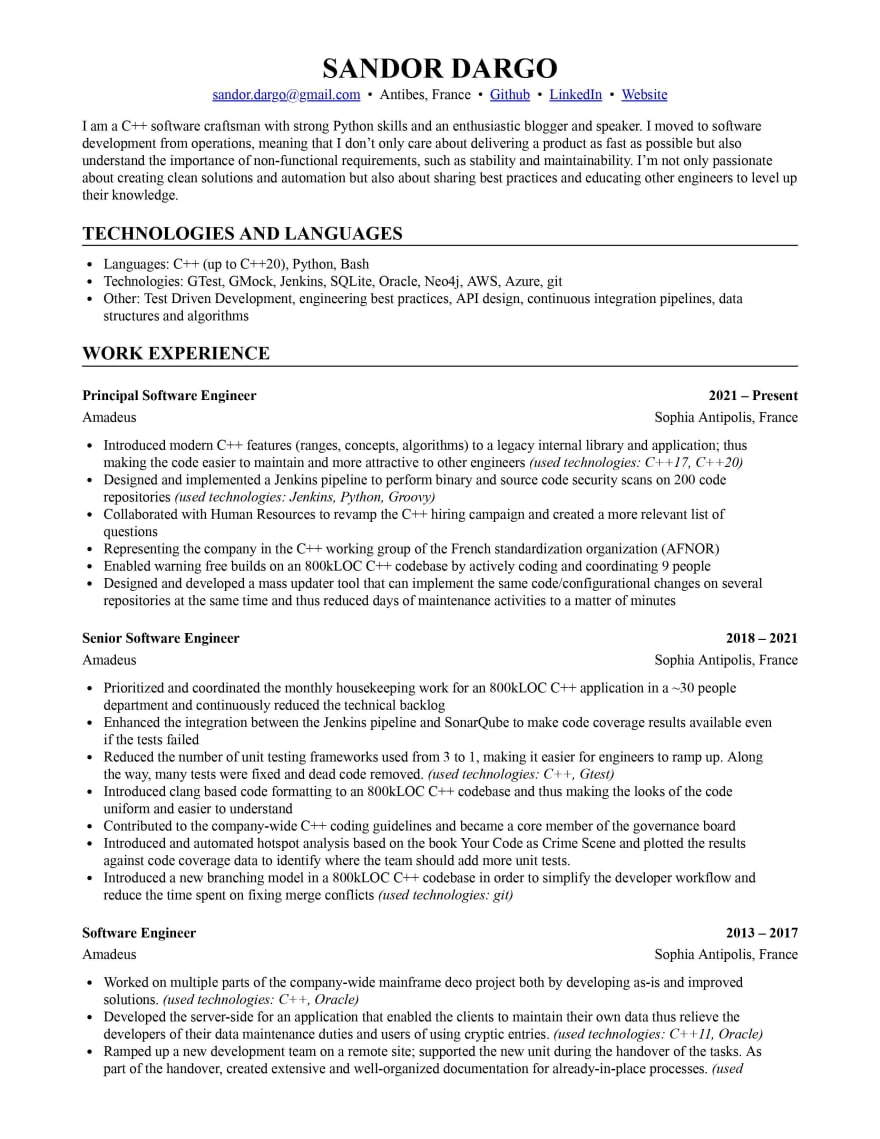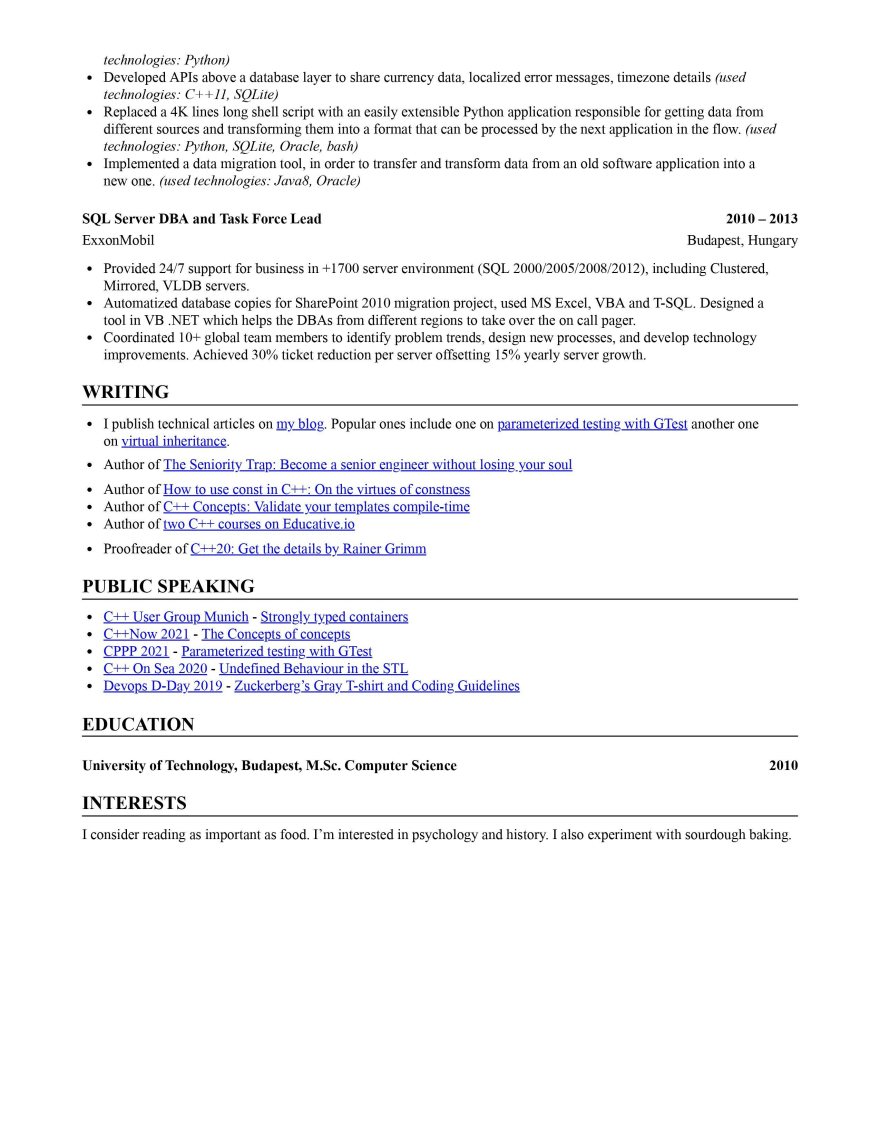I've been interested in how to write a good resume. Both because I keep one up to date and also because I saw a few ones recently as I helped my managers with technical interviews. I definitely saw bad CVs, and I didn't feel that I saw any great ones.
Includes my CVs. I tried different formats, but I didn't feel that I could pass all the info about myself that I wanted.
Though probably they were better than the average, at least I thought so. Thanks to The Tech Resume, I've been able to rewrite it completely and avoid some misunderstandings.
Such as that a resume has to be 1 page long. If you're an experienced person, it can and should be longer.
The book first walks through the hiring process. It explains what a typical hiring pipeline looks like, where and how a CV is used and what are its goals after all.
In the main part of the book, you learn about some ground rules of CV writing, how it should be structured and how you should write it in order to stand out. It's worth noting that often there are different pieces of advice for people with different experiences. Junior, mid-level and senior engineers should not write their CVs the same way.
Later, Gergely Orosz shares quite a few CV templates. First, there are some not so great CVs that were transformed into awesome ones. He also offers the evaluation of many different templates, including bad ones, so that we understand what works and what does not.
He finished with some pieces of advice for hiring managers, on how to run a good screening process.
Let's discuss a few ideas here in this review.
What is the goal of the CV and who is it for?
Is the goal of your resume to showcase your past experience?
That's a tempting answer!
But a wrong a one.
The goal of your CV is to make sure that you pass the first screening.
On average recruiters spend around 7 seconds on a CV to decide whether they should reject it or keep reading on and call the candidate.
Your CV has seven seconds to grab the attention of the recruiter or the hiring manager.
This doesn't mean that you should list things that are not true. That would backfire later on for sure.
It also doesn't mean that you should come up with a flashy design to literally grab the attention of the recruiter. In most cases it won't work, your CV will go directly to the no category.
It means that you should have a CV that is easy to read and that reveals the most important aspects to the recruiter at the first glance.
A few ideas on what they look for:
- Technologies you are proficient with
- Your years of experience
- Anything that clearly stands out, it might be your school if you're a new grad, your company or maybe your external projects, like a technical blog
Focus on the mandatory and your strong points to maximize your chances during those 7 seconds.
CV is about storytelling
We already discussed that the goal of the CV is to grab the attention of the recruiter or hiring manager.
But how?
Not just by listing your achievement, but also by telling a story - especially if you're a senior person or someone who changed careers.
You might ask how you can tell a story in a resume? One way of doing so is by making sure that progression stands out from it. You've been at the same company, same position for 10 years without a promotion? Are you sure?
Even if you worked for the same company, or the same team, show how you progressed from engineer to senior engineer, from senior to staff or principal engineer.
Make your promotions clearly visible so that the recruiters and hiring managers can see you can succeed in creating an impact and being recognized by your own company. That's an important trait, often it's easier to get promoted by job-hopping.
At the same time, you don't have to stick to your formal titles if they don't tell your story well. Choose them carefully, make sure that they don't lie but also that they communicate what you want to communicate.
As mentioned earlier, the goal of the CV is not to showcase everything you did in the past. You can omit old positions that wouldn't fit into your story.
Avoid sharing too much
Gergely Orosz's book shares tons of advice on what and how to put in your CV and also what you should avoid. Here are a couple of things to avoid:
- avoid sharing irrelevant contact details such as your mailing address. If it's needed you'll share it during the hiring process.
- avoid photos and non-required personal information such as your birth date, gender, religion, number of kids, whether you're married or not, etc. They are irrelevant to your job as a developer and can only create biases.
- while using bullet points is preferable because of easy readability, avoid sub-bullets. They achieve exactly the opposite effect.
- avoid any other format than PDF. PDF will render the same way wherever it's opened, unlike .doc/.docx/.rtf, etc.
- avoid rating your knowledge of technologies. Either they will have a temptation to grill you or they will not understand why you list something if you're not proficient with it. Don't rate, just list relevant technologies that you're comfortable with.
Putting it all together.
And here is how I updated my CV. First, here is the before state:
And here is the new version.
A couple of things to notice:
- I removed my photo. Although I don't think it matters - at a moment, they will see me anyway -, I gained some space.
- I went to a 2 pages format. I thought that one page that is expected, but I learned that it's not the case.
- Having two pages means that I can go into more in detail regarding my experience
- The format is less flashy, it's easier to quickly read through the most important details
It's worth mentioning that I generated it with resume.md which is a great tool. It was recommended by the author. I'm not a frontend dev, but even I could tweak the CSS enough so that I could fine-tune the format to my taste.
Conclusion
The Tech Resume Inside Out is a very thorough book by has reviewed thousands of resumes as a hiring manager. From this book, you'll learn about the hiring process in general, but more importantly, you'll get all the information you need to write a great CV. No matter whether you're a junior developer just starting out, someone with a bit of experience or a well-established professional, you'll get the best practices according to your level of experience.
A highly recommended read!
Connect deeper
If you liked this article, please
- hit on the like button,
- subscribe to my newsletter
- and let's connect on Twitter!





















